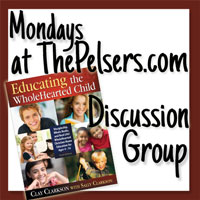We're in Chapter 12 and talking about discussion studies this week.
In some ways, the WholeHearted Learning model is a picture of the natural process of growth and maturation of a child – from dependance (parent-directed in childhood) to interdependance (family-centered in young adulthood) to independence (self-directed in adulthood). pg. 211
This chapter is full of ideas and suggestions for how to homeschool literature, history, geography, and fine arts. There are great resources and activity suggestions for each of these discussion studies areas.
Homeschoolers are often challenged with the question of holes in education. I love the picture that the Clarksons use of a hammock to support homeschooling. A hammock is full of holes, but the cords are strong enough to hold and support you. The holes are not a problem if the cords are strong. If the cords are not strong, then you'll fall through. If your children learn basics and how to think, they will have cords in their education that are strong and will support them in whatever direction the take in their lives.
Here are some of my other favorite things and insights from the chapter along with how we've been doing things in our homeschool:
- Focus on teaching a desire to read. Let your children see you reading.
- When reading aloud let your kids wiggle. Jonathan likes to play with Legos, cars, trains, or color a picture while I read. My only rule is that he must be quiet – no car/train noises while I'm reading!
- Create designated reading time. We've been doing this in the afternoons for quiet time. This is not free reading time for us. I give a selection of books to choose from. Right now, Jonathan is working his way through Boxcar Children #2.
- Narration. Jonathan is on the young side for narration but he's slowly picking it up. Our focus right now is more on the facts and sequence of what happened in the reading. I try to ask open ending question to prompt him to retell the story. He also enjoys drawing pictures of his idea of the story.
- Remember that history is a story. It is personal. This is one of the reasons that using good, whole books is essential. Textbooks tend to take the story out and pull the life out of history.
- Make a timeline. We're using the Book of Time from Sonlight. The Sonlight cores have timeline figures included that correspond to the reading and material covered in the core.
- We haven't done much in fine arts yet. We have a few poetry books that we read from as a part of our Sonlight core.
- Scripture memorization – We've been using Seeds Family Worship as a way to direct our memorization. {If you subscribe to my email or RSS feed, there's a code for 20% off on the CDs.}
- Either at dinner or at night before bed, we narrate for Daddy. We tell him about the stories we've been reading and the things we've been learning during the day.
How do you teach the literature, history, geography and fine arts?
.png)

